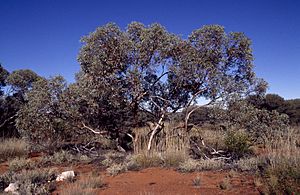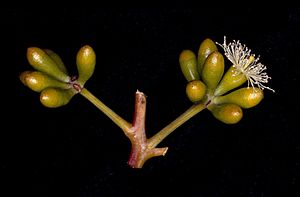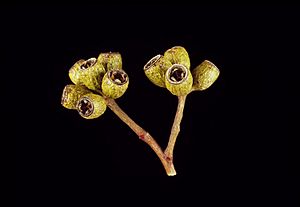Victoria Spring mallee facts for kids
Quick facts for kids Victoria Spring mallee |
|
|---|---|
 |
|
| Eucalyptus trivalva in the Great Victoria Desert in Western Australia | |
| Scientific classification | |
| Genus: |
Eucalyptus
|
| Species: |
trivalva
|
| Synonyms | |
|
Eucalyptus trivalvis J.W.Green orth. var. |
|
The Eucalyptus trivalva, often called the Victoria Spring mallee or desert mallee, is a type of mallee or small tree. It grows only in the dry, central areas of Australia. This plant has rough bark that peels off on some parts of its trunk. Higher up, its bark is smooth. It has long, thin leaves, flower buds that grow in groups, white flowers, and fruits shaped like cups or cones.
What the Victoria Spring Mallee Looks Like
The Victoria Spring mallee is a small tree or a mallee. It usually grows to be about 2 to 8 meters (6 to 26 feet) tall. It has a special woody base called a lignotuber. This helps it regrow after fires.
Its bark is rough and loose on the lower parts of its stems. It can be grey to dark grey-brown. Higher up, the bark is smooth and can look coppery, grey, or cream-colored. Its young branches are often yellowish.
Young plants have dull, bluish-grey leaves. These leaves are egg-shaped, about 50 to 80 mm long and 30 to 55 mm wide. Adult leaves are a dull greyish to bluish-green on both sides. They are shaped like a spear or an oval. These leaves are 50 to 140 mm long and 8 to 28 mm wide. They narrow down to a stalk called a petiole, which is 8 to 23 mm long.
The flower buds grow in groups of nine or eleven. They are found where the leaves meet the stem. Each group of buds is on a stalk called a peduncle, which is 5 to 20 mm long. The individual buds have tiny stalks called pedicels, about 1 to 4 mm long.
Mature buds are oval or spindle-shaped. They are 7 to 10 mm long and 4 to 6 mm wide. They are yellowish-green and have a cone-shaped or rounded cap called an operculum. This cap protects the flower inside.
The Victoria Spring mallee has white flowers. It blooms between January and August. After flowering, it produces a woody fruit. This fruit is a capsule shaped like a cup, cylinder, or cone. It is 5 to 10 mm long and 5 to 8 mm wide. The parts that open to release seeds are at or below the rim of the fruit.
How it Got its Name
The Eucalyptus trivalva was first officially described in 1936. A botanist named William Blakely wrote about it. The name trivalva comes from Latin words. "Tri" means "three," and "valva" means "valve." This name refers to the fruit of this plant, which usually opens with three parts, or "valves," to release its seeds.
Later, in 1988, another botanist named George Chippendale tried to change the name to Eucalyptus trivalvis. He thought it was a better fit. However, this change is not widely accepted by plant experts today.
Where the Victoria Spring Mallee Lives
The Victoria Spring mallee grows in dry and semi-dry areas of central Australia. You can find it on sandy plains, sand dunes, and ridges.
In Western Australia, it lives in the central parts of the Goldfields-Esperance, Pilbara, and Mid West regions. It can be found from places like Newman in the north down to Kalgoorlie in the south.
In the Northern Territory, it grows south of Alice Springs. In South Australia, it is found in the western parts. It often grows in open mallee areas on sandy soil with gravel, and on rocky hills.



